Hebrew Superheroes
by Eli Eshed
Please note that with the exception of this text in italics, all of the
information on this page is Eli's work. I am not Eli, so don't go e-mailing
me about what you like, don't like, agree with or don't agree with in the
article below. Also, if you want to use any of this for other sites, in whole
or in part, please make sure to credit him. Okay? This article is basically
a paired down version of the one on Hebrew
Comics, concentrating purely on the sections on superhero
characters.
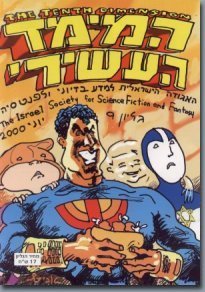 There
are some "comics experts" in Israel who had claimed that over history the
Jewish peoples had never shown much interest in art and comics, and that,
in their opinion, the reason why till the last few years, the comics medium
was not very popular in Israel. In fact, this claim show a complete ignorance
of American comics which over much of its history has been dominated by Jews,
both in the management of companies such as MARVEL, D.C and E.C which were
all originally created or owned by Jews and in the creative field . The most
popular comics genre, that of superheroes, was developed by Jews, such as
Jerry Siegel and Joe Shuster the creators of Superman, or Stan Lee and Jack
Kirby who created the Marvel universe. These names are just the tips of the
iceberg. It can be said that in the US, the influence of Jews in the comics
field was even stronger then their influence in Hollywood.
There
are some "comics experts" in Israel who had claimed that over history the
Jewish peoples had never shown much interest in art and comics, and that,
in their opinion, the reason why till the last few years, the comics medium
was not very popular in Israel. In fact, this claim show a complete ignorance
of American comics which over much of its history has been dominated by Jews,
both in the management of companies such as MARVEL, D.C and E.C which were
all originally created or owned by Jews and in the creative field . The most
popular comics genre, that of superheroes, was developed by Jews, such as
Jerry Siegel and Joe Shuster the creators of Superman, or Stan Lee and Jack
Kirby who created the Marvel universe. These names are just the tips of the
iceberg. It can be said that in the US, the influence of Jews in the comics
field was even stronger then their influence in Hollywood.
But in Israel, in contrast to the US, for years comics had been a marginal
phenomenon. By their very nature they had been thought to be fit only for
children.
There was however from the 30s to the 1970s an industry of original Israeli
Tarzan published from the 1930s to the 1970s.
There were some 1000 (!) original Israeli stories of the Man of the Jungle,
many of which are science fiction or fantasy. There are stories about Tarzan
battling space invaders, and going to other planets. There are stories of
horror, monsters, and the supernatural (vampires, mummies, etc.). Some stories
tell of Tarzan's encounters with well known characters such as
Flash Gordon (who had many adventures in space
together with Tarzan and Boy), Captain Marvel
( on whom there was another series of original stories in prose at Israel
at 1962), Dracula, Frankenstein,
Doctor Fu Manchu, and many others.
For more on that see:
http://www.angelfire.com/trek/erbzine15/erbz990.html
Another comics hero which was much translated to Hebrew was the Phantom.
See:
http://www.deepwoods.org/israel.html
and about the Hebrew stories of Captain Marvel see article with pictures
http://mag.stage.co.il/Articles/62
At this period both DAVAR LEYELADIM and HAARETZ SHELANU began publishing
stories about what can be called (though admittedly with much stretching
of the concept ) the first Israeli "super heroes". Among those was
Gidi Gezer ["Gidi Carrot"] whose adventures
were published in the 1950s in HAARETZ SHELANU. Gidi was an Israeli youth
at the time of the War of Independence who had super powers as a result of
eating carrots, and with these powers he battled the British and the Arabs.
Another super hero in the 1960s "Yoav Ben Halav"
["Yoav son of Milk"] was a super-powerful hero of comic-strip advertisements
for milk drinking. With time, these strips became quite intricate adventure
stories. Yoav was a boy who got his powers from drinking milk, and used these
powers to fight criminals, terrorists, and an evil wizard. Eventually he
even reached another planet and fought with the residents there. However,
with those exceptions the genre of super-heroes was all but unknown in Israel
until the 1970s. However with those exceptions the genre of super heroes
was utterly unknown in Israel till the 1970s.
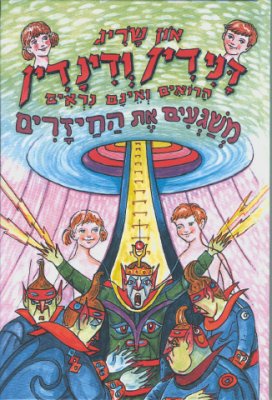
However the most famous Israeli super hero was not in a comics but in a prose
books series. In fact, he is probably the most famous creation of Science-Fiction
in Israel. "Dani-Din HaYeled HaRoe VeEino Nireh"
[Dani-Din the Invisible Boy] (1961 - 2001)
is a series for young children by veteran writer Shraga Gafni under the pseudonym
"On Sarig"
Gafni is one of the most prolific and best known writers for children in
Israel. His fame rest especially on this series which is the tale of invisible
boy Dani Din who fought many criminals, pirates and evil Arabs and particularly
Arabs leaders such as Saddam Hussein and Nasser. Over the years his adventures
have become more and more fantasy-like; Dani Din even went into space where
he fought an invading race of aliens. The latest book is Dani Din HaRoeh
v'Eino Nireh baJoongel [Dani Din the Invisible Boy in the Jungle] (M. Mizrahi,
2001) (drawings by M. Aryeh), in which Dani Din goes to Africa where he meets
an Israeli jungle man.
This series (totalling 29 volumes to date) are a part of the collective memory
of most Israelis the way "Superman" is for Americans. Art for it was drawn
by Arye Moskovitz (who signs his works M. Arye). Moskovitz is probably the
foremost illustrator in Israel both in popularity and productivity). Moskovitz
has done many thousand of books over a period of more than 50 years, perhaps
more than any other illustrator in history. His illustrations for Gafni's
Dani Din series, and for Tamar Borenstein Lazar's two series about talking
intelligent apes Kofiko and Chipopo, as well many other famous children's
series and books, are considered definitive, and are again part of the collective
memory of almost all Israelis.
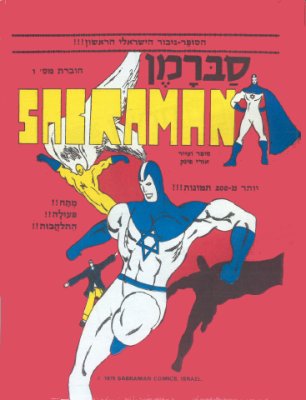
In 1978 there began a new period in Israeli comics when a young comics fan
Uri Fink began to publish the adventures of
Sabraman, an Israeli original super-hero
who had fought among others the Nazi Dr. Mengale. The stories were published
in both Hebrew and English, but were not very successful. For a short time,
though, there was a short strip about that hero in the Israeli English newspaper
"The Jerusalem Post".
This site has a picture of Sabraman:
http://www.geocities.com/Athens/Acropolis/5756/sbraman.htm
Since then, Fink has become the most successful (in fact the only successful)
and best known Israeli comics artist thanks to his ZBENG comics series. This
series is about the zany adventures of a group of schoolchildren, a series,
which became a national craze in Israel and created in its wake a successful
TV series and a book collection which are among the best sellers of Israeli
children's books..
The Hebrew site of Zbeng is:
http://images.maariv.co.il/safta/NP_37.html
Fink creates humorous comics, but is also a big SF fan. He has done a series
of humorous super-heroes. SuperShlumper is
a short hero, dressed in pajamas, who fights various ridiculous threats from
outer space. Hartzulei HaHalal [Space Hartzuls] is a parody of Star Trek.
His book Zbeng La'Mchashef HaMathil [Wham to the Beginning Magician] (Modan
2001) is a wild parody on the Harry Potter series in which Fink's standard
characters from his Zbeng [Wham!] series, a group of bizarre high school
students, play the characters from Harry Potter. With his wide knowledge
of SF, Fink regularly introduces into his comic-strips science fiction scenarios
and parodies based on such series as Star Trek and X-Man, as well as original
SF ideas of his own
But his best works can be quite serious. Fink's best work yet is
Profil 107 (Modan 1998), a sort of cynical
alternate history of Israel in which super-heroes aid the Israeli government
to achieve its political objectives, something like an Israeli WATCHMEN.
This is one of the masterpieces of Israeli comics.
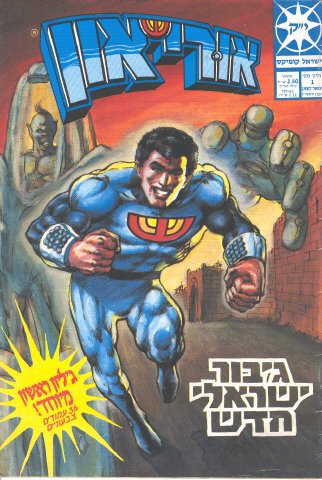
Another comics artist, much better known than Fink, Michael Netzer (better
known in the U.S.A as Mike Nasser), who had worked in the States with Neal
Adams, created a series about another super-hero URI ON in 1987. Uri on was
a kind of super Israeli soldier which had fought invading aliens and monsters
with the symbol of the Jewish temple lamp on his chest. But it was no more
successful then Sabraman. Much criticized for its "rightist" orientation,
the series was canceled after only 4 issues. The stories continued in a
children's magazine and then stopped in mid plot. Uri On had vanished .
More on Netzer:
http://www.advancedoncology.org/kalish/netzerreuters.htm
Since then there were no more attempts to create in Hebrew a "serious super
hero" though were plenty of attempts to create a satirical or humorous hero.
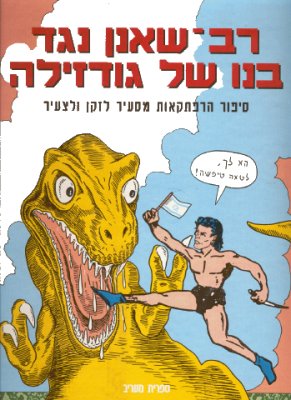
A well known adult comics painter was Dudu Geva who created many comic-strips,
such as those about the minor clerk Joseph, two detectives Ahalan Vasalan
and many other characters, in which there is a black but very funny description
of the crazy Israeli reality. Geva created a very original comics language
which came to a climax in his master piece "Rav
Sha'anan Neged B'no shel Godzilla [Mighty Sha'anan Against the Son of
Godzilla] (Sifriyat Ma'ariv, 1993). This wild humorous comic book tells of
the battle of an unfit Israeli super-hero against a family of dinosaurs who
threaten to destroy the universe after they have taken over a nuclear base
on another planet. This is one of the classics of Israeli comics, a parody
of science fiction literature, comics and just about everything else under
the sun.
But there was no more serious suoer hero at least until recently at 2003
when there was published by Modan an imaginary book by Eli Eshed (this writer)
and Uri Fink
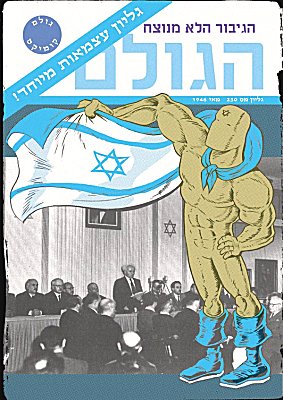
And recently at 2003 there was published by Modan an imaginary book by Eli
Eshed (this writer) and Uri Fink about the history of a comics series in
alternative Israel, an Israel in which there was a fully developed comics
industry since the 40s. The series and the book are called
THE GOLEM and the hero is a Hebrew super
hero to finish all Hebrew super heroes by that name . The book describe the
history of the series since the 40s when it was created by, among others,
a Jack Kirby who had immigrated in that alternate universe to Palestine like
many other Jews, through to the year 2003, and it describes many stories
in which the Golem is collaborating with various real well known Israeli
personalities such as Moshe Dayan and Ariel Sharon as well as imaginary ones
such as a version of his fellow super hero Danidin the Invisible boy from
famous book series with that name. There was a song and a clip with limited
animation about the Golem adventures created for the book.
Though imaginary, the book is based on real events and personalities of Hebrew
popular culture peoples such as Pinchas Sade Asher Dickstein and Giora Rotman
who are presented as writers and artists of the series in the alternative
world, and imitations of their stories and art (as a "Golem artworks") were
specifically and successfully made by Uri Fink. The book has won a great
success in Israel and has something of a cult following.. It serves as a
kind of "last word" about the Israeli comics super hero.
The GOLEM site :
http://www.multiverse.co.il/kaboom/golem/golem.html
The Golem Clip
http://www.multiverse.co.il/kaboom/golem/Main1.htm
the Golem book :
http://www.mitos.co.il/Book/BookFocus.asp?ID=142320&PopupID=0
Back to Israeli Superheroes
Home
All images and characters depicted on this site are copyright their respective
holders, and are used for informational purposes only. No infringement is
intended and copyrights remain at source.
 There
are some "comics experts" in Israel who had claimed that over history the
Jewish peoples had never shown much interest in art and comics, and that,
in their opinion, the reason why till the last few years, the comics medium
was not very popular in Israel. In fact, this claim show a complete ignorance
of American comics which over much of its history has been dominated by Jews,
both in the management of companies such as MARVEL, D.C and E.C which were
all originally created or owned by Jews and in the creative field . The most
popular comics genre, that of superheroes, was developed by Jews, such as
Jerry Siegel and Joe Shuster the creators of Superman, or Stan Lee and Jack
Kirby who created the Marvel universe. These names are just the tips of the
iceberg. It can be said that in the US, the influence of Jews in the comics
field was even stronger then their influence in Hollywood.
There
are some "comics experts" in Israel who had claimed that over history the
Jewish peoples had never shown much interest in art and comics, and that,
in their opinion, the reason why till the last few years, the comics medium
was not very popular in Israel. In fact, this claim show a complete ignorance
of American comics which over much of its history has been dominated by Jews,
both in the management of companies such as MARVEL, D.C and E.C which were
all originally created or owned by Jews and in the creative field . The most
popular comics genre, that of superheroes, was developed by Jews, such as
Jerry Siegel and Joe Shuster the creators of Superman, or Stan Lee and Jack
Kirby who created the Marvel universe. These names are just the tips of the
iceberg. It can be said that in the US, the influence of Jews in the comics
field was even stronger then their influence in Hollywood.




